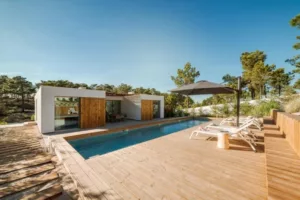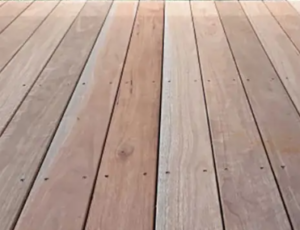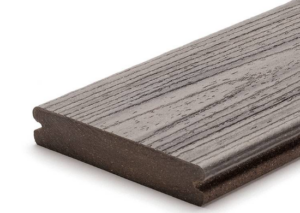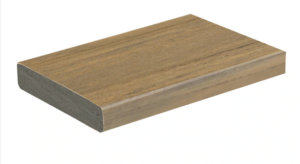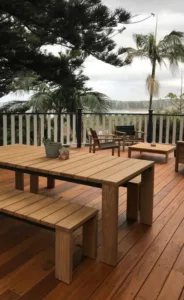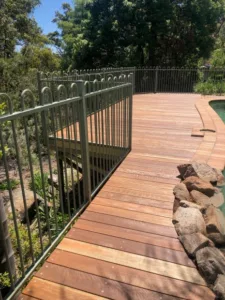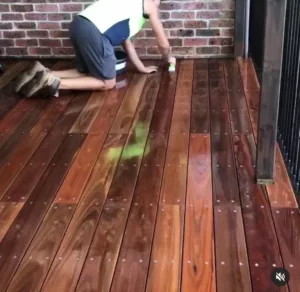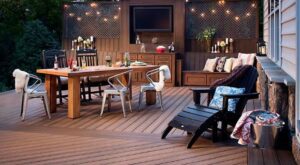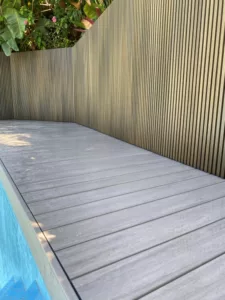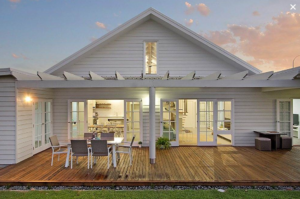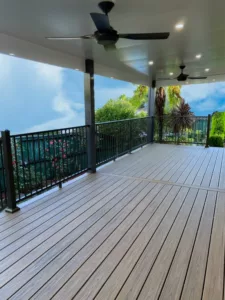The Ultimate Guide to choosing deck materials
Welcome to The Ultimate Guide to Choosing Deck Materials. In outdoor living, a well-designed deck is more than just an extension of your home—it’s a canvas for experiences, a stage for cherished moments, and a gateway to the beauty of the great outdoors. As you create your dream deck, one crucial decision stands at the forefront: choosing deck materials.
This comprehensive guide will explore the intricacies of selecting the perfect deck materials for your project. Beyond being mere construction components, these materials wield the power to shape the very essence of your outdoor space. As you’ll soon discover, the decision isn’t confined to aesthetics alone but extends to functionality and longevity.
Imagine a deck seamlessly blending with its surroundings, inviting you to relish sunrises with your morning coffee or host laughter-filled gatherings under the stars. Now, envision a deck that stands resilient against the tests of time, enduring the elements while requiring minimal maintenance. This is the magic that the right deck materials can weave.
The choice of deck materials is a trifecta of impact—enhancing aesthetics, enriching functionality, and dictating the deck’s lifespan. Natural wood exudes classic charm, while composite and PVC materials usher in modern innovation. The material you choose sets the stage for your deck’s identity—will it exude rustic warmth or contemporary elegance?
But it’s not just about looks; it’s about how your deck will serve you. Will it be a bustling hub for entertaining, a peaceful haven for relaxation, or a balance of both? The right materials can cater to your lifestyle, from withstanding high foot traffic to ensuring ease of maintenance.
Longevity is the silent companion of the right material choice. A well-selected material can withstand the onslaught of weather, the passage of time, and the trials of use, offering you a deck that remains as captivating as the day it was built.
As you navigate this guide, remember that choosing deck materials isn’t merely a decision; it’s an investment in the experiences and memories your deck will foster. Join us as we delve into the world of wood, composite, PVC, and more, exploring their virtues and helping you chart a course toward a deck that harmonises beauty, functionality, and enduring quality.
Exploring Various Deck Material Options Available in the Market
The world of deck materials is a tapestry woven from various choices. Natural wood is a classic option with its timeless appeal and rich diversity. Conversely, composite materials blend innovation and sustainability, while PVC materials offer a low-maintenance alternative. Each material brings a different flavour, inviting you to tailor your choice to your vision and requirements.
Natural Wood:
The warmth and authenticity of natural wood are unrivalled. Different wood species offer distinct hues and grains, allowing for personalisation.
However, wood requires regular maintenance to prevent weathering, rot, and fading.
Composite Decking:
Composite materials combine wood fibres and recycled plastics for a durable, eco-friendly option.
They offer resistance to rot, insects, and fading, often requiring minimal upkeep.
On the flip side, composites may have a higher upfront cost compared to wood.
PVC Decking:
PVC materials are virtually maintenance-free and resistant to moisture and stains.
They retain their colour and appearance over time without sealing or staining.
Yet, the higher cost might be a consideration for some homeowners.
Comparing Factors Like Durability, Maintenance, and Cost
Durability plays a crucial role in your material choice. While natural wood brings a touch of authenticity, composites and PVC materials, boast impressive longevity due to their resistance against the elements.
Maintenance is another pivotal factor. Natural wood demands regular staining and sealing, while composites and PVC materials require minimal upkeep, saving you time and effort in the long run.
Cost considerations round out the equation. While natural wood might present a more budget-friendly upfront expense, the potential for ongoing maintenance costs should be factored in. Composites and PVC materials often have higher initial costs, but their durability and minimal maintenance may provide financial relief over time.
As you navigate the labyrinth of material options, remember that each choice carries its own set of advantages and trade-offs. By delving into the specifics of each material, you empower yourself to make an informed decision that aligns not only with your design vision but also with your lifestyle and long-term goals.
Natural wood decking
Natural wood is a timeless classic in deck materials, evoking a sense of charm and authenticity that resonates with nature. In this section, we’ll delve into the enchanting world of natural wood decking, exploring its unique qualities, the allure of different wood species, and the responsibilities that come with its beauty.
There’s an innate allure to natural wood decking that transcends trends. Its warmth underfoot, the variation in grain patterns, and the way it gracefully weathers over time are the hallmarks of wood’s enduring charm. With natural wood, you’re not merely building a deck; you’re creating an atmosphere—a space that invites you to connect with the environment in a way that no other material can replicate.
Within the realm of natural wood, various species stand out for their unique attributes. Spotted Gum, known for its wonderful hues and colours and natural resistance to insects, offers a welcoming reddish-brown hue. Blackbutt, with its warm honey tones tones, brings an elegance that only matures with age. treated pine deck boards, a cost-effective option, is infused with preservatives to enhance its durability, making it a practical choice for many.
Each species brings its personality to your deck, adding depth to your design and reflecting your taste. Whether you opt for the exciting embrace of Spotted Gum, the sophisticated beauty of Blackbutt, or the dependable practicality of pressure-treated Pine, your deck will carry the essence of the wood you choose.
Maintenance Requirements and Considerations
Yet, the embrace of natural wood comes with responsibilities. To ensure your deck’s longevity, regular maintenance is essential. Staining and sealing protect the wood from weathering, moisture, and UV rays. The frequency of care varies with wood species and climate.
Consider the location of your deck—direct sunlight, humidity, and heavy foot traffic all play a role in maintenance needs. Regular inspections and addressing issues promptly can prevent more extensive repairs.
While natural wood offers unmatched beauty, it requires an ongoing commitment to care. It’s a partnership between you and the material, where your dedication ensures that your deck remains a source of pride and a haven of beauty for years to come.
Natural wood is a testament to tradition in deck materials, inviting you to embrace its character and cultivate its grace over time. As you craft a natural wood deck, remember that with proper care, it will age gracefully, telling a story of seasons, memories, and the enduring beauty of the natural world.pine
Composite Decking: The Modern Alternative
In deck materials, composite decking emerges as a contemporary marvel—a marriage of innovation and sustainability that redefines outdoor living. In this segment, we’ll unravel the composition, virtues, and misconceptions surrounding composite decking. From its eco-friendly essence to its resilience and ease of care, composite materials present a compelling modern alternative for decking projects of all scales.
Composite decking is a fusion of wood fibres and recycled plastics, resulting in a material that captures the aesthetics of wood while embodying the durability of synthetic elements. This amalgamation creates a decking solution that withstands the rigours of weather, foot traffic, and time without succumbing to warping, splintering, or fading. The result? A deck that exudes the beauty of wood without the constant maintenance that wood often demands.
Composite materials bear an eco-friendly mantle—using recycled plastics reduces waste and lessens the demand for virgin materials. Additionally, composite decking’s longevity translates to fewer replacements, further contributing to sustainability.
Durability is another key attribute. Composite decking defies the challenges of moisture, insects, and UV exposure, boasting a lifespan that can outlast traditional wood decks. This durability translates to fewer repairs, no oiling or staining, and an extended enjoyment of your outdoor space.
Low maintenance is perhaps one of composite decking’s most alluring features. No staining, sealing, or sanding is necessary; periodic cleaning is usually sufficient to maintain its appearance. This convenience saves time, effort, and resources over the life of your deck.
Composite decking has encountered its share of misconceptions, ranging from appearance to heat retention. However, technological advancements have led to diverse options that mimic the look and feel of wood while effectively dissipating heat. Today’s composite materials offer a variety of finishes, textures, and colours, catering to a spectrum of design preferences.
Composite decking’s adaptability makes it suitable for various environments—whether you’re crafting an urban oasis or a rural retreat. Its resistance to moisture makes it ideal for poolside decks, while its durability shines in areas with challenging weather conditions.
Composite decking isn’t just an alternative; it’s a testament to innovation’s embrace of nature. As you explore modern materials, remember that composite decking isn’t just a choice; it’s a conscious decision that marries aesthetics, sustainability, and durability. It’s a testament to design evolution, offering a deck that resonates with your vision and stands the test of time.
PVC Decking: Unravelling the Possibilities
In the realm of deck materials, PVC decking emerges as a remarkable contender—an embodiment of modern engineering that redefines the concept of durability and beauty. In this section, we’ll delve into the distinctive features and advantages of PVC decking, exploring its unparalleled resistance to the elements, its role in combating wear and tear, and its undeniable place in contemporary deck design.
PVC decking is a symphony of innovation—a fusion of synthetic materials that stands as a beacon of durability. Composed primarily of polyvinyl chloride, it offers a level of resilience that transcends traditional materials. The result? A deck that defies the challenges of moisture, insects, and the relentless grasp of time. As you step onto PVC decking, you enter a realm where footprints fade, splinters vanish, and maintenance recedes into the background.
PVC’s armour is multifaceted. It possesses a natural resistance to moisture, rendering it impervious to warping, rot, and decay—a quality that makes it ideal for waterfront properties and humid climates. Insects, seeking vulnerabilities in traditional wood, find no solace in PVC’s formidable composition.
Unlike PVC, the sun’s unyielding rays are another adversary, causing fading and discolouration in some materials. Its inherent resistance to fading ensures that your deck’s vibrancy persists, season after season.
Comparing PVC with Other Materials and its Place in Contemporary Deck Design
When placed alongside other materials, PVC decking holds its own with pride. While wood requires regular maintenance and composites blend innovation with natural aesthetics, PVC is the pinnacle of low-maintenance endurance. Its uniform appearance and colour retention further elevate its appeal.
In contemporary deck design, PVC is a beacon of possibility. Its sleek surface exudes modernity, while its ability to mimic the textures of natural wood ensures it doesn’t forsake warmth. Whether you’re crafting a minimalist haven or a vibrant social space, PVC’s adaptability makes it an ideal canvas.
PVC decking isn’t merely a material; it promises enduring beauty and effortless care. As you explore the possibilities for your outdoor space, remember that PVC isn’t just decking; it’s a testament to the marriage of design and innovation. It’s an invitation to step onto a surface that beckons with beauty and stands as a testament to the triumph of human ingenuity over the elements.
Sustainability and Eco-Friendly Options
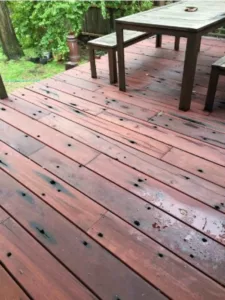
Exploring Sustainable Deck Material Choices for Environmentally Conscious Homeowners
Sustainable deck materials offer a harmony between outdoor living and ecological stewardship. These choices reflect a commitment to preserving natural resources, minimising waste, and reducing the carbon footprint associated with construction projects. For homeowners who seek to enjoy their outdoor space and protect the planet, sustainable deck materials provide a means to bridge aesthetics with ethics.
Reclaimed wood weaves stories of history into your deck. Salvaged from barns, factories, and warehouses, it boasts character, resilience, and a rustic charm that cannot be replicated. By giving new life to old wood, you honour history while curbing demand for fresh timber.
With its rapid growth and natural strength, bamboo offers a renewable alternative. Its cultivation doesn’t deplete forests, and its regrowth cycle is swift. Choosing bamboo aligns with a commitment to sustainable resource management.
Composite materials crafted from recycled content—whether plastics, wood fibres, or both—mirror innovation’s dedication to environmental conservation. These composites reduce landfill waste and conserve raw materials by transforming discarded materials into durable decking.
Selecting a deck material goes beyond aesthetics; it’s an ethical choice that echoes through time. Responsible material selection contributes to habitat preservation, reduces deforestation, and minimises pollution. By choosing sustainable options, you become a steward of the environment, leaving a positive legacy for future generations.
As you contemplate the materials shaping your outdoor haven, remember that your choice is an investment in your comfort and the planet’s health. By embracing sustainability, you create a ripple effect that extends beyond your deck, inspiring others to make conscious choices and collectively forge a greener, more harmonious world.
Cost Considerations and Budgeting
Creating a captivating deck is an endeavour that blends imagination with practicality, and at the heart of this process lies the realm of cost considerations and budgeting. In this section, we’ll navigate the intricacies of various deck materials’ costs. From the initial investment to long-term savings, we’ll provide insights that empower you to make informed decisions. Balancing your aspirations with budgetary realities, we’ll guide you in crafting a deck that resonates with your vision and harmoniously with your financial plan.
The spectrum of deck materials unfolds with a range of costs, each linked to its unique attributes. Natural wood, while alluring in its authenticity, can vary significantly in price based on the wood species and quality. Composite materials, known for their durability and low maintenance, might require a higher initial investment. With its resilience and convenience, PVC decking often occupies the upper end of the price spectrum.
Beyond material expenses, consider installation costs, permits, and any additional features such as railing systems, lighting, and accessories. These factors collectively contribute to the overall budget.
Remember that the initial cost is just one facet of the equation—weigh it against the long-term savings, reduced maintenance, and enhanced enjoyment of certain materials. While seeking cost-efficiency is natural, ensure your budget doesn’t compromise quality, durability, or overall satisfaction with the finished product.
Natural wood, for instance, might require ongoing staining and maintenance, which adds to its long-term cost. Composite and PVC materials, while pricier upfront, often lead to considerable savings over the years due to their reduced maintenance requirements and extended lifespan.
Budgeting for your deck isn’t just about numbers; it’s about aligning your dreams with practicality. Finding an equilibrium between financial prudence and creating an outdoor sanctuary sets the stage for a deck that harmonises with your lifestyle and reflects the essence of responsible decision-making.
Maintenance and Longevity
A deck is more than a structure—it’s a canvas for memories and a portal to the outdoors. But just as an artist maintains their canvas, a deck requires attention to ensure its longevity and continued allure. In this section, we’ll delve into maintenance, unravelling the unique demands of different materials and their impact on your deck’s lifespan. From preventive measures to tailored care, we’ll guide you in nurturing a deck that remains a vibrant backdrop to countless moments.
Deck materials wear different personalities, and their maintenance needs reflect these distinctions. Natural wood often demands staining and sealing to protect against weathering, while composite and PVC materials—generally low-maintenance—require cleaning to ward off grime and maintain their vibrancy.
Each material’s upkeep impacts not only its appearance but also its longevity. Neglecting maintenance can lead to deterioration, fading, or even structural issues.
Maintenance is the guardian of your deck’s longevity. Regular care prevents deterioration and ensures that your deck weathers time with grace. Neglect accelerates wear, leading to premature aging and costly repairs.
Think of maintenance as an investment—by dedicating time and effort to proper care, you’re extending your deck’s life, preserving its beauty, and safeguarding your initial investment.
Tips for Proper Care to Ensure the Longevity of the deck Chosen Material
Tips for Proper Care to Ensure the Longevity of the deck Chosen Material
Wood Decks: Stain and seal your deck every few years to protect against moisture and UV rays. Regularly inspect for rot, warping, and loose boards, addressing issues promptly. Sweep and clean the surface regularly to prevent debris buildup.
Composite Decks: While lower maintenance, composite decks benefit from regular cleaning to prevent mould, mildew, and staining. Avoid abrasive cleaners that might damage the surface.
PVC Decks: Clean with mild soap and water to maintain PVC’s appearance. Regularly inspect and address any issues with the deck structure or fasteners.
Remember, maintenance isn’t just a chore—it’s a ritual of care. It’s your declaration that your deck is worth preserving, worth nurturing for the memories it will hold and the experiences it will facilitate. By dedicating time to maintenance, you’re breathing life into your deck, ensuring that it remains a steadfast companion through the seasons, years, and the stories that will unfold upon its surface.
A quick recap
Design and Aesthetic Choices
Crafting a deck is akin to crafting an expression—a visual narrative that mirrors your style and amplifies your home’s architecture. In this section, we’ll delve into the fascinating world of design and aesthetic choices, exploring how different materials contribute to the overall visual tapestry of your deck. From the interplay of textures to the symphony of colours and patterns, we’ll guide you in weaving a design that resonates with your style and harmonises with your home’s architectural context.
Addressing How Different Materials Contribute to the Overall Aesthetic of a Deck
Materials are the foundation upon which aesthetics are built. Natural wood decks exude warmth and authenticity, blending seamlessly with nature. Composite materials offer a modern canvas with various finishes and textures to suit your vision. PVC decking, with its sleek surface, aligns harmoniously with contemporary design.
Each material carries its own aesthetic identity, influencing your outdoor space’s overall mood and ambience.
Discussing Design Options, Colour Choices, and Pattern Possibilities
Design choices are your artistic tools—a palette of colours, textures, and patterns that bring your vision to life. Wood decks can be stained to achieve a spectrum of shades, while composite and PVC materials offer an array of pre-designed colour options.
Patterns also play a pivotal role—arranging deck boards diagonally, creating herringbone designs, or incorporating intricate inlays can elevate the visual intrigue of your deck.
Highlighting How Material Selection Aligns with Personal Style and Architectural Context
Your deck extends your home’s personality, and your material selection is a visual conduit. A recycled wood deck might resonate with a rustic farmhouse, while a modern home might find its match in a sleek composite deck.
Consider architectural context
Your deck should complement your home’s aesthetic, creating a harmonious transition between indoor and outdoor spaces and possibilities that shape the creation of a stunning outdoor living space. Let’s recap the key points discussed and reinforce the importance of making an informed decision that harmonises with your needs, preferences, and the insights provided.
Understanding Different Deck Materials
You’ve explored various deck materials, each with distinct personalities and virtues. Natural wood offers timeless charm, composite materials blend innovation with durability, and PVC decking is a testament to modern resilience.
Sustainability and Eco-Friendly Options
The significance of sustainable choices has been highlighted, from reclaimed wood’s rustic allure to the renewable potential of bamboo and the innovation of composites crafted from recycled content. Responsible material selection extends beyond your deck—it echoes your commitment to environmental stewardship.
Cost Considerations and Budgeting
The dance of budgeting has been illuminated, revealing the range of costs tied to various materials and the long-term savings confident choices offer. While cost is a pivotal factor, it’s balanced by long-term benefits, reduced maintenance, and the satisfaction of investing wisely.
Maintenance and Longevity
The essential role of maintenance in preserving a deck’s longevity has been emphasised. From regular care to vigilant inspections, maintenance safeguards your investment, ensuring your deck remains a vibrant canvas for cherished moments.
Design and Aesthetic Choices
The aesthetic journey of design has been explored, showcasing how different materials contribute to the visual identity of your deck. Design choices, colour palettes, and patterns offer tools to create an outdoor space that resonates with your unique style and complements your home’s architecture.
Conclusion: A Balanced Decision
In crafting your dream deck, the choice of materials is a symphony—a harmonious balance of attributes, needs, and personal preferences. As you stand at this crossroads, armed with insights, it’s important to remember that no single material reigns supreme. Instead, the right choice resonates with your lifestyle, budget, and design vision.
Envision your deck as an extension of yourself—a space that tells your story, reflects your values, and welcomes you into embracing nature. Your decision transcends trends; it echoes through the seasons and the memories you’ll create upon its surface.

